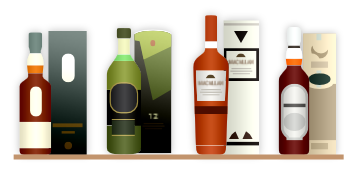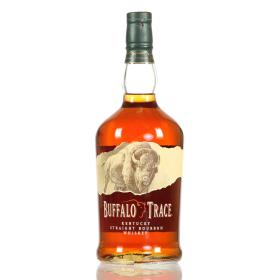What does the information on whisky bottles tell us?
Similar to wine bottles, you can read a lot of information on a whisky label. We'll show you how to read the label in detail so that you can tell the difference between whiskies. A few basic rules will help you to distinguish between simple and high-quality whiskies.
Reading whisky labels correctly: Important information at a glance
Using three different labels, we will show you what is important.
From the simple blended whisky to the more detailed single malt and the exclusive single cask bottling - discover the differences!
Blended Scotch Whisky
Using the well-known and best-selling blended whisky Famous Grouse in Scotland as an example, we show you what information you can find on the label. Much of it is obvious, but we will briefly explain other details.
Scotch
Whisky may only be labelled Scotch if it has matured for at least 3 years in oak casks in Scotland. Without the Scotch designation, this whisky could come from India, for example. India is one of the world's largest whisky-producing countries.
Age
If no exact age is stated on the label, you can assume that the whisky it contains is usually only the required minimum age of 3 years. Do not be confused by words such as 'Rare'. The Famous Grouse pictured, for example, is one of the best-selling whiskies in the world.
Bottle content
Various units are permitted when specifying the bottle content. For example, bottles can be labelled with 70 cl or 0.7 litres. The letter 'e' after the contents refers to the determination of the volume. 'e' stands for 'estimated'. In a technical process such as bottling, there are always small deviations.
Interesting to know: The most common bottle size on the American market is 75 cl.
Alcohol content
The alcohol content is given as a percentage of the bottle content (volume). Theoretically, you could also state a percentage of the weight. However, this is not permitted by law.
Single malt Scotch whisky
Single malt Scotch whisky is made exclusively from malted barley and only comes from a single distillery. This is why the name of the distillery is always stated on the label. If you find the words 'blended malt' on a bottle, it is usually a malt whisky blended from several distilleries. Please do not confuse such a blended malt with a blended Scotch (see above). In the latter, large quantities of industrial whisky (grain whisky) have been added.
Region
The term single malt Scotch whisky may be preceded by the region, e.g. 'Highland'. The classic regions are Highlands, Speyside, Lowlands, Islay and Campbeltown. Since a change in the law in 2009, other regional designations (e.g. Orkney, Arran) may now also precede the whisky designation.
Age
The age on the label of a whisky bottle always indicates the age of the youngest whisky contained in this bottle. Single malt whiskies also usually combine whiskies of different ages, although they all come from the same distillery.
As a general rule, the longer a whisky matures, the smoother and often better it becomes, as sharp flavours degrade over time. However, age alone is not decisive, as other factors, such as cask size, also play an important role. Whiskies aged for 12 years in small casks often develop faster and become softer than those aged for 18 years in large casks, for example.
Age is an important indicator, but not the sole criterion - so don't just be guided by the number on the label!
There are now also many bottlings without an age indication - the so-called NAS whiskies. Here, older whiskies are blended with younger ones until a harmonious flavour is achieved.
Alcohol content
Higher quality whiskies are usually bottled with a higher alcohol content. This reflects the philosophy of many producers to offer the buyer of a more expensive bottle a more intense and authentic flavour experience.
But be careful: many whiskies develop their flavours better when diluted with a little water. This has nothing to do with "adulteration" or watering down, but rather with the possibility of bringing out the complex flavours better.
And there is another advantage to whiskies with a higher alcohol content: a bottle with a higher alcohol content often lasts longer, as it can be individually diluted according to preference - and is therefore more productive than a bottling that has already been reduced to drinking strength.
Explained in more detail! NAS whiskies
Whiskies without an age statement are known as NAS whiskies. NAS stands for"No Age Statement".
This means that no specific age of the whisky is stated on the bottle. Instead, these whiskies can consist of a blend of distillates of different ages. Producers often emphasise other characteristics such as flavour, cask maturation or special ingredients rather than focusing on age. Common reasons for NAS whiskies include flexibility in production with no minimum age statement, the ability to use younger whiskies to increase production and a focus on flavour profile rather than age.
NAS whiskies are now very common, especially in premium and special editions. Some well-known examples are:
Cask strength bottlings
The bottling of cask strength single malt Scotch whisky is a speciality not to be missed. The whisky comes undiluted from the cask into the bottle!
Age
Cask strength bottlings are labelled with precise information on the time of distillation so that the age of the whisky can be verified. This information, together with the date of bottling, is often found on single cask bottlings. The cask type is also indicated, which helps you to better assess the flavour of the whisky before tasting it.
Limited quantity
As whisky matures individually in casks, the flavour of each cask is different. This is why cask-finished whiskies are only available in limited quantities. If a whisky is successful in sales, the bottler will try to bottle a similar cask - with a slightly different flavour. The number of bottles bottled is often stated alongside the bottle number.
Alcohol content
Don't be put off by the high alcohol content of a cask bottling. These whiskies are usually reduced to drinking strength with still, low-mineralised spring water. This means the bottle lasts twice as long. In addition, the fresh dilution ensures a more intense flavour and gives you the opportunity to experiment with aromas, which significantly enhances your taste experience.
Filtering
When it comes to filtering, bottlers' opinions differ: some swear by the filtering process, while others are strictly against it. Some cool the whisky to a few degrees Celsius before filtering in order to capture all the components that are difficult to dissolve (chill filtering). Further information can be found in the article Alcohol and water.
Conclusion
The rule here is: more knowledge, better whisky enjoyment!
Understanding the information on a whisky label is the key to finding the right bottle for your taste. From the age to the alcohol content to the origin - every detail provides valuable information about the quality and character of the whisky. Our labelling guide will help you make a more informed choice in future.

















To comment, you must be logged in